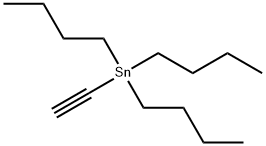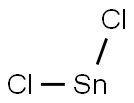Tributyltin chloride
Synonym(s):TBTC;Tributylchlorotin;Tributyltin chloride
- CAS NO.:1461-22-9
- Empirical Formula: C12H27ClSn
- Molecular Weight: 325.51
- MDL number: MFCD00000521
- EINECS: 215-958-7
- SAFETY DATA SHEET (SDS)
- Update Date: 2024-12-18 13:37:16

What is Tributyltin chloride?
Chemical properties
Colorless or light yellow clear liquid. Soluble in the common organic solvents; including alcohol, heptane, benzene, and toluene; insoluble in cold water, but hydrolyzes in hot water.
The Uses of Tributyltin chloride
Tributyltin Chloride is a triorganotin compound with insecticidal acitivity. It is an endocrine disruptor as well as an inhibitor for the V-ATPases (potential targets in the treatmen t of diseases such as osteoporosis and cancer). Tributyltin Chloride has the functions of antiseptic, sterilization and mildew proof and widely used in wood preservation, ship paint, etc. Further, it is used in hot end glass coating and rodent-repellent for cable coatings.
What are the applications of Application
TBTC is a useful organometallic for proteomics research
Preparation
Tributyltin chloride is prepared by a redistribution reaction by combining stannic chloride and tetrabutyltin:
3 (C4H9)4Sn + SnCl4 → 4 (C4H9)3SnCl.
Definition
ChEBI: Tributyltin chloride is an inorganic molecular entity.
Hazard
A poison by ingestion and skin contact. A severe eye irritant. Tributyl tin compounds are extremely toxic to marine life.
Flammability and Explosibility
Not classified
Toxicology
Tributyltin chloride (TBTCL) is a widely used biocide and heat stabiliser for PVC compositions. TBTCL has been detected in humans and may cause harmful effects on the thyroid, cardiovascular and other organs in humans. It is also an endocrine disruptor with toxic effects on the male reproductive system.TBTCL causes apoptosis and cell cycle arrest. Activation of endoplasmic reticulum stress and inhibition of autophagy are responsible for TBTCL-induced apoptosis and cell cycle arrest.
Properties of Tributyltin chloride
| Melting point: | -9 °C |
| Boiling point: | 171-173 °C25 mm Hg(lit.) |
| Density | 1.2 g/mL at 25 °C(lit.) |
| vapor pressure | <0.01 mm Hg ( 20 °C) |
| refractive index | n |
| Flash point: | >230 °F |
| storage temp. | 2-8°C |
| solubility | 0.017g/l |
| form | liquid |
| color | colorless |
| Specific Gravity | 1.186 |
| Water Solubility | PRACTICALLY INSOLUBLE |
| Sensitive | Moisture Sensitive |
| BRN | 3535715 |
| Exposure limits | ACGIH: TWA 0.1 mg/m3; STEL 0.2 mg/m3 (Skin) NIOSH: IDLH 25 mg/m3; TWA 0.1 mg/m3 |
| Stability: | Hygroscopic |
| CAS DataBase Reference | 1461-22-9(CAS DataBase Reference) |
| NIST Chemistry Reference | Tri-n-butyltin chloride(1461-22-9) |
| EPA Substance Registry System | Tributyltin chloride (1461-22-9) |
Safety information for Tributyltin chloride
| Signal word | Danger |
| Pictogram(s) |
 Skull and Crossbones Acute Toxicity GHS06  Health Hazard GHS08  Environment GHS09 |
| GHS Hazard Statements |
H301:Acute toxicity,oral H312:Acute toxicity,dermal H315:Skin corrosion/irritation H317:Sensitisation, Skin H319:Serious eye damage/eye irritation H372:Specific target organ toxicity, repeated exposure H410:Hazardous to the aquatic environment, long-term hazard |
| Precautionary Statement Codes |
P202:Do not handle until all safety precautions have been read and understood. P273:Avoid release to the environment. P280:Wear protective gloves/protective clothing/eye protection/face protection. P301+P310:IF SWALLOWED: Immediately call a POISON CENTER or doctor/physician. P305+P351+P338:IF IN EYES: Rinse cautiously with water for several minutes. Remove contact lenses, if present and easy to do. Continuerinsing. |
Computed Descriptors for Tributyltin chloride
| InChIKey | GCTFWCDSFPMHHS-UHFFFAOYSA-M |
Tributyltin chloride manufacturer
JSK Chemicals
ARRAKIS INDUSTRIES LLP
Anand Agencies
ASM Organics
New Products
(S)-3-Aminobutanenitrile hydrochloride 4-Methylphenylacetic acid N-Boc-D-alaninol N-BOC-D/L-ALANINOL Tert-butyl bis(2-chloroethyl)carbamate 3-Morpholino-1-(4-nitrophenyl)-5,6-dihydropyridin- 2(1H)-one Furan-2,5-Dicarboxylic Acid Tropic acid 1-Bromo-3,5-Di-Tert-Butylbenzene S-2-CHLORO PROPIONIC ACID ETHYL ISOCYANOACETATE 2-Bromo-1,3-Bis(Dimethylamino)Trimethinium Hexafluorophosphate 4-IODO BENZOIC ACID 3-NITRO-2-METHYL ANILINE 1-(2,4-DICHLOROPHENYL) ETHANAMINE (2-Hydroxyphenyl)acetonitrile 4-Bromopyrazole 2-(Cyanocyclohexyl)acetic acid 4-methoxy-3,5-dinitropyridine 1-(4-(aminomethyl)benzyl)urea hydrochloride 2-aminopropyl benzoate hydrochloride diethyl 2-(2-((tertbutoxycarbonyl)amino) ethyl)malonate tert-butyl 4- (ureidomethyl)benzylcarbamate Ethyl-2-chloro((4-methoxyphenyl)hydrazono)acetateRelated products of tetrahydrofuran






![2-[[(2-ethylphenyl)(2-hydroxyethyl)amino]methyl]-3,3-difluoro-Propanenitrile](https://img.chemicalbook.in/CAS/GIF/2647-14-5.gif)

You may like
-
 Tributyltin chloride 1461-22-9 98%View Details
Tributyltin chloride 1461-22-9 98%View Details
1461-22-9 -
 1461-22-9 Tributyltin chloride, 98% 99%View Details
1461-22-9 Tributyltin chloride, 98% 99%View Details
1461-22-9 -
 Tributyltin chloride CAS 1461-22-9View Details
Tributyltin chloride CAS 1461-22-9View Details
1461-22-9 -
 Tributyltin chloride CAS 1461-22-9View Details
Tributyltin chloride CAS 1461-22-9View Details
1461-22-9 -
 1461-22-9 TRI-N-BUTYL TIN CHLORIDE 99%View Details
1461-22-9 TRI-N-BUTYL TIN CHLORIDE 99%View Details
1461-22-9 -
 1461-22-9 99%View Details
1461-22-9 99%View Details
1461-22-9 -
 Tri-n-butyltin Chloride CAS 1461-22-9View Details
Tri-n-butyltin Chloride CAS 1461-22-9View Details
1461-22-9 -
 Tri-n-butyl tin chloride 98% CAS 1461-22-9View Details
Tri-n-butyl tin chloride 98% CAS 1461-22-9View Details
1461-22-9